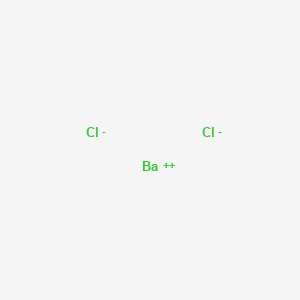
Barium(2+) dichloride
Overview
Description
See also: Barium chloride (preferred).
Scientific Research Applications
Analytical Chemistry
Gravimetric Determination of Sulfates
Barium dichloride is primarily used in analytical chemistry for the gravimetric determination of sulfate ions. In this process, a solution containing sulfate ions is treated with barium dichloride, resulting in the formation of barium sulfate, which precipitates out of solution. This reaction can be represented as follows:
The precipitate is then filtered, dried, and weighed to determine the sulfate content in the original sample. This method is widely employed due to its accuracy and reliability in quantifying sulfate concentrations in various samples, such as water and soil .
Industrial Applications
Purification of Brine Solutions
In industrial settings, barium dichloride is utilized for the purification of brine solutions in caustic chlorine plants. It helps remove impurities that can affect the quality of chlorine produced . Additionally, it plays a role in the manufacturing of heat treatment salts used in metal processing.
Production of Pigments
Barium dichloride serves as a precursor for producing various pigments, including Lithol red and Red Lake C. These pigments are used in paints and coatings due to their vibrant colors and stability .
Oil and Gas Industry
In the oil and gas sector, barium compounds are essential for creating drilling muds. Barium sulfate, derived from barium dichloride, is commonly used to enhance the density of drilling fluids, aiding in the lubrication and cooling of drill bits during operations .
Environmental Applications
Water Treatment
Barium dichloride is employed in water treatment processes to remove sulfate ions from wastewater. Its ability to precipitate barium sulfate makes it effective in reducing sulfate levels to meet environmental regulations .
Case Study 1: Barium Chloride Toxicity Management
A recent case study highlighted the toxic effects of barium dichloride when ingested. The study documented a fatal case of barium chloride poisoning, emphasizing the importance of handling this compound with care due to its high toxicity levels. The report noted that while barium sulfate is safe for ingestion, other forms such as barium chloride are bioavailable and pose significant health risks .
Case Study 2: Industrial Use in Drilling Fluids
Another study focused on the application of barium sulfate derived from barium dichloride in drilling fluids for oil extraction. The research demonstrated that using barium-based drilling muds improved drilling efficiency and reduced equipment wear by providing better lubrication compared to traditional fluids .
Summary Table of Applications
| Application Area | Specific Use | Chemical Reaction/Process |
|---|---|---|
| Analytical Chemistry | Gravimetric determination of sulfates | |
| Industrial Production | Purification of brine solutions | Removal of impurities |
| Production of pigments | Synthesis of Lithol red | |
| Oil & Gas Industry | Drilling muds | Enhances density and lubricates drill bits |
| Environmental Science | Water treatment | Precipitation of barium sulfate |
Properties
Molecular Formula |
BaCl2 |
|---|---|
Molecular Weight |
208.23 g/mol |
IUPAC Name |
barium(2+);dichloride |
InChI |
InChI=1S/Ba.2ClH/h;2*1H/q+2;;/p-2 |
InChI Key |
WDIHJSXYQDMJHN-UHFFFAOYSA-L |
SMILES |
[Cl-].[Cl-].[Ba+2] |
Canonical SMILES |
[Cl-].[Cl-].[Ba+2] |
Origin of Product |
United States |
Synthesis routes and methods I
Procedure details








Synthesis routes and methods II
Procedure details








Disclaimer and Information on In-Vitro Research Products
Please be aware that all articles and product information presented on BenchChem are intended solely for informational purposes. The products available for purchase on BenchChem are specifically designed for in-vitro studies, which are conducted outside of living organisms. In-vitro studies, derived from the Latin term "in glass," involve experiments performed in controlled laboratory settings using cells or tissues. It is important to note that these products are not categorized as medicines or drugs, and they have not received approval from the FDA for the prevention, treatment, or cure of any medical condition, ailment, or disease. We must emphasize that any form of bodily introduction of these products into humans or animals is strictly prohibited by law. It is essential to adhere to these guidelines to ensure compliance with legal and ethical standards in research and experimentation.













